Old Khmer Inscription (K.1056) on a Bronze Sconce (P.Ch.23)
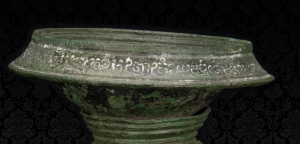
Si Mahosot, Prachinburi, Thailand. Prachinburi National Museum. Bronze hoard, sconce P.Ch.23 (après National Museums Database)
o 1115 śaka vraḥ juṃnvan vraḥ pādakamrateṅañ śrījayavarmmadeva ta vraḥ ārogyasāla nāsaṃvok o
Oval Bronze Water Bowl (P.Ch.20) with an Inscription on Old Khmer (K.1055)
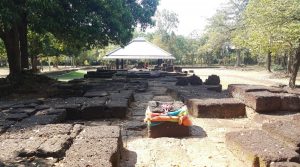
Si Mahosot Archaeological Site (Prachinburi Province, Thailand). View from the east showing excavated foundations.
Prachinburi National Museum (Prachinburi). Finds from
Si Mahosot (including bowls P.Ch.20 and P.Ch.24).
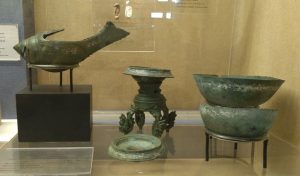
Prachinburi National Museum. Bronze hoard from Si Mahosot, (including bowls P.Ch.20 and P.Ch.24, conch P.Ch.22, sconce P.Ch.23).
Conch Shell in Bronze (P.Ch.22) with an Inscription in Old Khmer
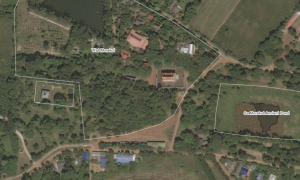
Si Mahosot Archaeological Site (Prachinburi Province, Thailand). Satellite view. (Wikimapia).

Si Mahosot Archaeological Site (Prachinburi Province, Thailand). View from the east showing excavated foundations.
Prachinburi National Museum (Prachinburi). Finds from Si Mahosot (including conch P.Ch.22).
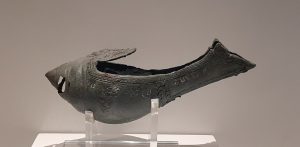
Bronze conch with Khmer inscription. Prachinburi National Museum (P.Ch.22).
Bronze mirror base inscription (K.1053)
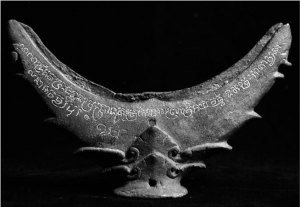
Bronze mirror inscription K.1053 (après ฐานข้อมูลจารึกในประเทศไทย)
1. o 1115 śaka vraḥ juṃnvan vraḥ pāda kamrateṅ añ śrijayavarmma da ta vraḥ ārogyasā
2. la nā śiravatsapura (or: avadhyapura?)
Bronze mirror base (P.Ch.21) with an inscription (K.1053) in Old Khmer

Si Mahosot Archaeological Site (Prachinburi Province, Thailand). Satellite view. Satellite view. (Wikimapia).

Si Mahosot Archaeological Site (Prachinburi Province, Thailand). View from the east showing excavated foundations.
Prachinburi National Museum (Prachinburi). Finds from Si Mahosot (including mirror base P.Ch.21).

Bronze mirror base with inscription K.1053 (après ฐานข้อมูลจารึกในประเทศไทย)
Bronze mirror base with an inscription (K.973) in Old Khmer
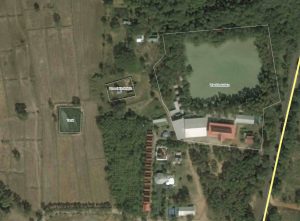
Prasat Khok Ngiu (tambon Pakham, amphoe Pakham, changwat Buriram). Satellite view (Wikimapia).
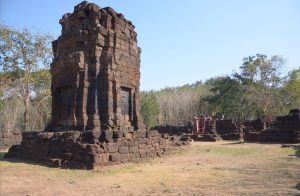
Prasat Khok Ngiu (tambon Pakham, amphoe Pakham, changwat Buriram). Ruins of the Khmer complex after conservation.
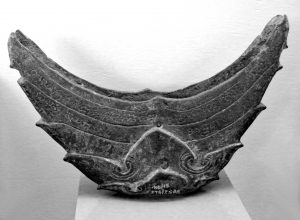
Prasat Khok Ngiu (tambon Pakham, amphoe Pakam, changwat Buri Ram). Mirror base with inscription in Old Khmer (K.973). Bangkok National Museum.
Bronze mirror inscription (K.973)

Prasat Khok Ngiu (tambon Pakham, amphoe Pakham, changwat Buriram). Mirror base, Bangkok National Museum.
Source: SEAclassics Old Khmer
Donation to a Royal Hospital
| Śaka 1114 = CE 1192 |
Say Fong : Stèle des hôpitaux de Jayavarman VII
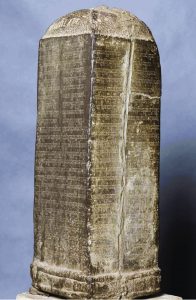
Say Fong (Laos). Stèle de Jayavarman VII (après Lorrillard 2018).
Say Fong : Inscription of Jayavarman VII
Inscription with information on Hospital Networks in ancient Cambodia.
IN03070 Mäḍirigiriya Pillar Inscription
Granting of immunities regarding land. Concerns a village and a hospital.
The inscription was discovered by the Archaeological Commissioner, H. C. P. Bell, in August 1897 in the course exploring the ruins of Mäḍirigiriya in Tamankaḍuva, about forty-six miles east-south-east of Anurādhapura. It is engraved on four sides of a stone pillar and consists of 95 lines in the Sinhalese alphabet of the 10th and early 11th centuries A.D. The text is dated to the third year of king Abhā Salamevan and records the granting of certain immunities in respect of the land within the four boundaries of Mäḍiligiri-Ätveher-Piyan-gala in Rantisǟ in the district of Bidervatu-kuḷiya. Wickremasinghe suggests that the biruda Abhā Salamevan refers in this instance to Kassapa V.
